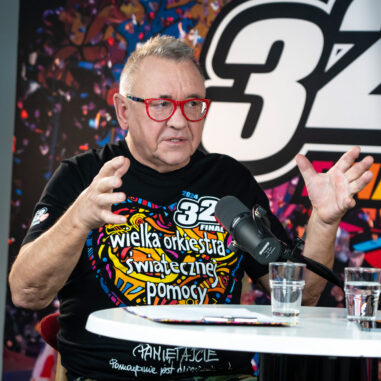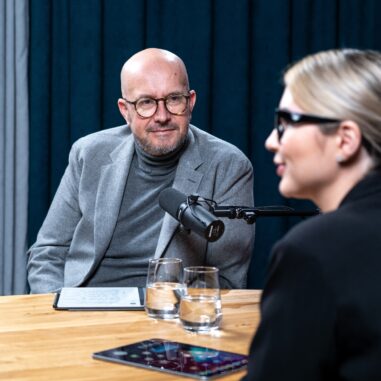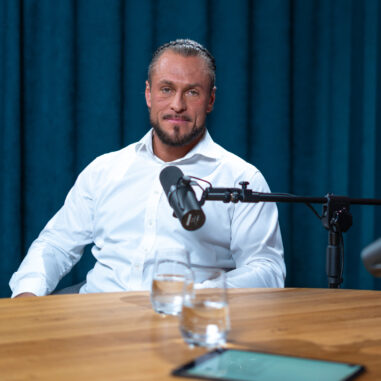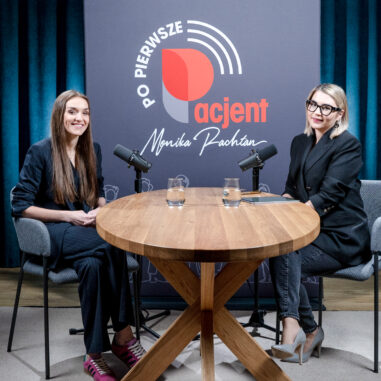
Don't eat, don't drink... or parenteral nutrition. Episode 35
It is hard to believe that there are people among us who do not eat and drink in the traditional way. Parenteral nutrition is a daily reality for around 1,500 Poles. For them, it is the only way to live and feel good. In the latest episode of the programme 'Po pierwsze Pacjent', Monika Rachtan talks to Professor Jacek Sobocki, MD, PhD, about the importance of parenteral nutrition and how it helps patients to function in everyday reality.
Parenteral nutrition is an alternative method of nutrition necessary for people who cannot take food in the traditional way. Thanks to this method, it is possible to deliver all nutrients by intravenous route. In Poland, it is used daily by as many as 1,300 adults and about 200 children. Sometimes it is the only option to live and feel better.
Parenteral nutrition in Polish health care
Parenteral nutrition is a method that has been developing in Poland for 40 years. It is not only an important medical achievement, but also a testament to the innovation of Polish doctors. Poland, being a pioneer in the development of parenteral nutrition in Europe, has specialised feeding clinics, such as the one run by Professor Jacek Sobocki, MD, at the Orlowski Hospital in Warsaw.
Every day, around 1,300 adults and 200 children in Poland benefit from this method of nutrition, with access to world-class care. Treatment is fully funded by the National Health Fund and tailored individually to each patient. Patients are provided not only with medical support, but also with training for patients and their families on how to manage nutrition at home.
Polish doctors and specialists are recognised as among the best in the world in the field of parenteral nutrition. This is testament to the high level of care and experience we have gained over the past decades. As a result, our country has become an international role model in this field of medicine.
Parenteral nutrition - for whom?
Parenteral nutrition is a method of treatment used in various medical situations. First and foremost, this method is essential for patients who, as a result of illness or surgery, have lost a significant portion of their intestine and are unable to feed orally. Such patients, like those with renal failure who require dialysis, are dependent on parenteral nutrition to enable them to live.
Another group of patients for whom parenteral nutrition is indicated are those with surgical complications. In cases where subsequent surgical interventions are unsuccessful or the patient is too weak for further operations, parenteral nutrition allows patients to recover.
Oncology patients represent another important group benefiting from parenteral nutrition. In cases of advanced cancer that prevents normal nutrition, this method allows the patient's strength to be maintained, which is crucial for the continuation of oncology treatment. This allows patients to maintain a high quality of life and independence.
The last group are patients with gastrointestinal diseases such as Crohn's disease or intestinal damage after radiotherapy, where the intestines do not function well enough to allow adequate nutrition.
Intravenous mixed feeding at home
Parenteral nutrition consists of providing patients with a special nutritional mixture intravenously. This mixture consists of essential nutrients such as amino acids (protein), glucose (sugars), fats, vitamins and minerals. All are delivered directly into the bloodstream. The mixture is individually tailored to the needs of each patient, taking into account, first and foremost, their state of health.
Any trained patient can make such a mixture by themselves at home or with the help of relatives. The training process begins in the hospital, where the patient is fitted with a special feeding catheter and then learns how to attach the mixture themselves. In Poland, this system has been in operation for 40 years and is fully funded by the National Health Fund. Patients, both those in hospital and those at home, are carefully instructed on how to manage their nutrition safely and effectively.
Parenteral nutrition is not a complicated process - learning how to prepare and connect the mixture is comparable to other daily activities and does not require specialised skills. However, it is important that the patient is well prepared and understands the importance of diligence in this process. In cases where the patient is too debilitated or unable to manage feeding on their own, the role of family or carers is important, and help can also be sought from care facilities.
Administering intravenous mixture at home is not only a medical issue, but also a logistical one. Organising the delivery and storage of the mixture, setting up regular follow-up visits and monitoring the patient's condition are all crucial to the success of the therapy. With careful preparation and medical support, patients can continue their treatment in the comfort of their home, which has a positive impact on their wellbeing and quality of life.
Pregnancy in women on parenteral nutrition
Women who receive parenteral nutrition can safely become pregnant and give birth to healthy babies. In Poland, there have already been about twenty cases of babies being born whose mothers have benefited from parenteral nutrition. During pregnancy, the feeding formula is adapted to the changing needs of mother and child, which requires close cooperation between doctors specialising in parenteral nutrition and the gynaecologists who manage the patient's pregnancy.
The decision on the method of delivery in women on parenteral nutrition depends on their overall health status. Parenteral nutrition in itself does not influence the choice of delivery method, whether natural or by caesarean section. The success of parenteral nutrition in pregnancy confirms the effectiveness of this method and the quality of medical care in Poland.
Parenteral nutrition is an effective treatment method, but there are certain situations in which it cannot be used. Contraindications to parenteral nutrition may arise for various reasons, both medical and ethical .
Contraindications to the use of parenteral nutrition
Medical contraindications to the use of parenteral nutrition include very severe medical conditions of patients. Examples of such situations are patients in severe shock, in the intensive care unit, or those with severe water-electrolyte, acid-base disorders. In such cases, parenteral nutrition is not feasible, at least until the patient's condition is stabilised.
There are also ethical contraindications, especially in the most difficult medical cases, such as the terminal phases of diseases, when the patient is in the dying phase. In such situations, prolonging the patient's life at all costs, including through parenteral nutrition, may be considered ethically unjustifiable. In such cases, physicians may decide not to initiate or terminate parenteral nutrition in order not to prolong the patient's suffering.
These decisions are taken with great care and require an individual assessment of each case, taking into account both the medical and ethical aspects of the situation. Doctors in these situations carefully consider the patient's medical condition, prognosis and possible benefits and risks of parenteral nutrition, always keeping the patient's welfare in mind.
Parenteral nutrition is a key solution for people who cannot eat traditionally. Used by around 1,500 people, including 1,300 adults and 200 children, this method is funded by the National Health Service and offered in specialised clinics. Essential for patients with intestinal damage, surgical complications or oncological diseases, it enables them to self-manage their nutrition at home and maintain a normal lifestyle.
The Patient First programme is available on multiple platforms, including Spotify, Apple Podcasts and Google Podcasts.
Transcription
Monika Rachtan
Good morning, Monika Rachtan here. I would like to welcome you to another episode of the programme "Patient First". In Poland, approximately 1,300 adults and 200 children are fed parenterally every day. It turns out that they live as long as healthy people and, according to specialists, may even live longer. Most Polish patients on parenteral nutrition know my guest today, Professor Jacek Sobocki, who heads the Nutrition Clinic at the Orlowski Hospital in Warsaw. A warm welcome to you, Professor.
Jacek Sobocki
Good morning, Madam Editor, good morning to you.
Monika Rachtan
Professor, I read on the internet that Polish nutritionists are considered to be the elite in the world, even better than specialists from the United States. Is this true?
Jacek Sobocki
Editor, medicine does not have a world championship, and neither does science. We respect each other and do not rank each other. However, thank you for your words. Our treatment results are among the best in the world.
Monika Rachtan
That is, parenteral nutrition improves the quality of life of patients with certain conditions. But why are patients fed in this way?
Jacek Sobocki
There are three main groups of patients. The first are those who, as a result of illness or surgery, have lost a large part of their bowel and cannot eat normally. For them, intravenous nutrition is the chance of a lifetime, just as dialysis is for people with kidney failure. These patients will be on intravenous nutrition for life. They may live longer than the average population.
Monika Rachtan
Where does this longer life expectancy come from?
Jacek Sobocki
It is possible that this is due to the fact that patients fed intravenously only receive healthy ingredients, unlike normal eaters who do not always consume healthy products.
Monika Rachtan
This is interesting. And what are the other patient groups?
Jacek Sobocki
The second group are patients with surgical complications who are too weak for subsequent operations. They receive parenteral nutrition to strengthen themselves. The third group is oncology patients who cannot feed normally due to advanced cancer. With intravenous nutrition, they can continue their cancer treatment. There is also a fourth group, patients with gastrointestinal diseases, such as Crohn's disease or intestinal damage after radiotherapy. In these cases, intravenous feeding allows sufficient nutrition.
Monika Rachtan
Are there patients who have been fed intravenously since birth?
Jacek Sobocki
Yes, there are such patients. These may be people who have lost their bowel in the first days of life or have congenital underdevelopment of the gastrointestinal tract. I specialise in treating adults, so my experience with these patients begins when they turn eighteen and move into my care from paediatric hospitals.
Monika Rachtan
How do you assess the care of these patients in paediatric hospitals? Is it at the same high level as in adults?
Jacek Sobocki
We work with excellent centres such as the Children's Health Centre. The care is fascinating and world-class.
Monika Rachtan
Is there a critical indicator that determines the need for immediate inclusion of parenteral nutrition?
Jacek Sobocki
There are such indicators. However, it is important to distinguish between temporary and permanent parenteral nutrition. What I was referring to is home feeding for the long term - months, years or even decades. We turn it on when the patient is unable to feed orally sufficiently, which is particularly dangerous in sick patients.
Monika Rachtan
What does the patient pathway look like when the doctor decides to include intravenous feeding permanently?
Jacek Sobocki
We have two pathways. If the patient is in hospital and cannot be fed orally, the doctor contacts a parenteral nutrition centre. If the patient is at home and their oral nutrition proves to be insufficient, they can be referred to a centre via an outpatient route. There are several such centres in Poland.
Monika Rachtan
Is a list of these centres available?
Jacek Sobocki
Yes, a list is available, e.g. through the National Health Service. Centres are located all over Poland, in many cities.
Monika Rachtan
Can any doctor refer a patient to such an outpatient clinic?
Jacek Sobocki
In Poland, the home parenteral nutrition procedure is financed by the NFZ, so a referral from a NFZ doctor is needed.
Monika Rachtan
How to organise nutrition at home? What should the patient's relatives do?
Jacek Sobocki
This system has been in place for 40 years. Preparing the patient for home feeding is a key part of the process. We support patients and their families in this adaptation.
Monika Rachtan
What is the patient's preparation for self-administered intravenous feeding at home?
Jacek Sobocki
First, we insert a special feeding catheter for the patient. We then individually select the feeding mixture. Although it does not always differ between patients, it is tailored to each patient's individual needs.
Monika Rachtan
So for each patient the mixture is individually selected?
Jacek Sobocki
Yes, each patient has an individually selected mixture. The choice depends on a number of factors, such as biochemical test results and the patient's wellbeing. Mixtures may be similar for some patients, but are always individually tailored.
Monika Rachtan
Can a patient's nutritional needs change?
Jacek Sobocki
Of course, and that is our goal. We want to improve the patient's condition, so as the condition improves, we change the mix. Checks take place at least once every three months, but sometimes even weekly.
Monika Rachtan
What happens once the mix is established and the patient is prepared for home feeding?
Jacek Sobocki
These processes run in parallel. When the patient is ready to leave the hospital, we train them or their relatives to know how to prepare and connect nutrition themselves.
Monika Rachtan
Are patients able to prepare nutrition themselves?
Jacek Sobocki
Yes, patients are able to and should do this themselves. No one will do it better than they themselves. We have 40 years of experience in training patients and we teach them with full empathy. If necessary, the patient can be assisted by relatives.
Monika Rachtan
Is it difficult to prepare nutrition at home?
Jacek Sobocki
It is no more difficult than driving a car or operating a computer. However, it requires time and a positive attitude. If someone wants to learn, they will always achieve it. Sometimes we need to train someone from the family, especially in the case of elderly or lonely patients.
Monika Rachtan
What happens when a patient does not have a loved one to care for them? Are there professionals who can take over care at home?
Jacek Sobocki
These are difficult situations. Our system is not quite prepared for such cases. Ideally, such a patient should be placed in a care and treatment facility.
Monika Rachtan
We know that there is a problem with the availability of such places in Poland.
Jacek Sobocki
Availability is limited and many facilities cannot cope with intravenous feeding. The requirements for establishments are not fully defined. They should be tailored to the needs of patients at home, not as in hospitals. High requirements may do more harm than good, as facilities may not be able to meet them. It is important to have an empathetic approach so that the requirements can be met.
Monika Rachtan
We are therefore waiting for changes in this area.
Jacek Sobocki
Yes, we are waiting for the relevant regulations.
Monika Rachtan
How are intravenous feeding bags delivered to the patient's home?
Jacek Sobocki
We have three delivery systems. The first, is that we supply the ingredients separately and the patient prepares them themselves at home. The second system, is RTU (ready to use) bags, which only require the addition of vitamins and electrolytes. The third system, are bags prepared in the hospital pharmacy and delivered once a week to the patient.
Monika Rachtan
Does the patient have to pay for these bags?
Jacek Sobocki
No, parenteral nutrition is reimbursed by the National Health Fund in Poland, including bags, mixtures, disinfectants, dressings and care of the centre. There is no cost to the patient.
Monika Rachtan
What type of ports are used for intravenous feeding in Poland?
Jacek Sobocki
We use three types of venous access, or different types of cannulas. Each has its own use depending on the patient's needs and condition.
Monika Rachtan
What determines the choice of intravenous feeding port type?
Jacek Sobocki
The choice depends mainly on patient preference and the clinical situation. The most commonly used catheter is the Broviac catheter, inserted into the main vein leading to the heart and exiting under the skin on the chest. If the patient already has a chemotherapy port in place that is used and is not infected, we use this port. The third type is a long insertion from the hand, but with the tip near the heart.
Monika Rachtan
Are patients bothered by these ports?
Jacek Sobocki
The port is an additional obligation and can be a nuisance, but it is necessary. Like ear piercings serving a higher good, the port serves the health of the patient.
Monika Rachtan
What are the rules for caring for the port?
Jacek Sobocki
There are specific procedures that we teach patients. They are not complicated, but they do require diligence. We train patients how to operate the port, prepare the nutrition and connect it.
Monika Rachtan
Can intravenous feeding fully replace normal food?
Jacek Sobocki
From a nutritional point of view, yes. However, food also has pleasure and social aspects that intravenous feeding does not satisfy. However, it is the only option for some patients.
Monika Rachtan
How do patients cope with social situations such as family dinners?
Jacek Sobocki
In most cases, patients can consume small amounts of food orally. In social situations this is more accepted. A support group from other patients is very important and the stories of people fed intravenously and leading normal lives can be inspiring.
Monika Rachtan
Do patients use a psychologist to learn to talk about their intravenous nutrition?
Jacek Sobocki
Yes, there is a psychologist on our ward. He helps patients adapt to their new life situation and deal with their fears.
Monika Rachtan
How long does it take to administer the feeding mix?
Jacek Sobocki
The duration depends on the needs of the patient. We usually aim for it to last around 16 hours. Shortening this period can lead to health problems. Some patients need continuous feeding for 24 hours a day.
Monika Rachtan
What are the logistics of intravenous feeding for patients who work? Can they walk to work with a feeding bag?
Jacek Sobocki
Going to work with a standard feeding bag rack is impractical, but there are intravenous feeding backpacks with pumps that regulate the flow. These allow patients to function normally, go to work or carry out daily activities.
Monika Rachtan
Do women fed intravenously have a chance at motherhood?
Jacek Sobocki
Yes, intravenous nutrition in itself does not prevent pregnancy. It all depends on the disease that requires intravenous nutrition. The nutritional requirements during pregnancy are adjusted in collaboration with the gynaecologist.
Monika Rachtan
What does childbirth look like in women who are fed intravenously?
Jacek Sobocki
The decision on the mode of delivery depends on the health of the mother and baby. The main limitation is the disease that caused the need for intravenous feeding, not the feeding itself. In Poland, more than a dozen healthy babies have been born from mothers fed intravenously.
Monika Rachtan
Are there any contraindications to intravenous feeding?
Jacek Sobocki
Contraindications to intravenous feeding are both medical and ethical. Medical relates to severe medical conditions of the patient, while ethical relates to the decision not to start feeding in situations where the patient is in the dying phase so as not to prolong suffering.
Monika Rachtan
Can intravenous feeding be seen as a form of persistent therapy?
Jacek Sobocki
Yes, this is a concept related to intravenous feeding, especially in an ethical context. The boundary is fluid and requires caution in assessing whether to continue intravenous feeding or to abandon it in the circumstances.
Monika Rachtan
What is the return to normal eating after long-term intravenous feeding?
Jacek Sobocki
The patient must gradually get the bowel used to the work. It starts with a diet that is easily digestible and absorbable, gradually increasing the load. This process can take from a week to several months, but reflexes such as chewing and swallowing do not disappear.
Monika Rachtan
Do patients on intravenous feeding experience taste and smell?
Jacek Sobocki
The sense of taste and smell does not disappear in people on intravenous nutrition. intravenous nutrition itself has no taste or smell, but patients can experience different taste sensations.
Monika Rachtan
How do elderly people who are fed intravenously take medication for other conditions?
Jacek Sobocki
If the patient cannot take orally, we adapt the form of drug administration. These may be transdermal or sublingual systems, or altered forms of medication that are more easily absorbed. It is important to monitor the patient's condition to see if the treatment is effective.
Monika Rachtan
Thank you, Professor, for these reflections. It is important that we all remember the human dimension of medicine. I would like to raise one more topic. Are there any support programmes for IVF patients in Poland? Can patients count on psychological help, social support or financial support?
Jacek Sobocki
Yes, there are various forms of support for people on intravenous nutrition. First of all, as I mentioned, parenteral nutrition is financed by the National Health Fund, which is a great financial support. In addition to this, psychologists are available in many centres, including ours, to help patients adjust to their new life situation. We also try to organise meetings and support groups where patients can share experiences and advice. It is very important that IVF patients do not feel isolated and have the opportunity to share experiences.
Monika Rachtan
If so, is there a community or group of IVF patients where they can support each other?
Jacek Sobocki
Yes, there are such groups, both formal and informal. Many of them are active on the Internet, for example in discussion forums or on social media. Patients exchange information, advice and experiences there. We as doctors try to support these initiatives and be available to patients who are looking for additional information or support.
Monika Rachtan
It is important to educate patients. Professor, here is a question from a patient who is about to be put on parenteral nutrition and has expressed concerns about the feeding bags.
Jacek Sobocki
I understand the patient's concerns. However, parenteral nutrition without a bag is not possible. It is possible that this is a new treatment for short bowel syndrome, which allows for a faster recovery, but does not eliminate the need for parenteral nutrition to begin with.
Monika Rachtan
What are these new methods?
Jacek Sobocki
There are three main methods. The first is intestinal transplantation, which is, however, complicated and of limited effectiveness. The second is surgical lengthening of the bowel. The third is new drugs to promote intestinal regeneration, unfortunately these are not yet reimbursed in Poland.
Monika Rachtan
Can these drugs replace parenteral nutrition?
Jacek Sobocki
No, these drugs do not replace parenteral nutrition, but they can shorten its duration by promoting intestinal regeneration.
Monika Rachtan
We are therefore waiting for the reimbursement of these drugs. Thank you for talking to us and passing on your knowledge to our listeners. I hope they will be able to use it.
Jacek Sobocki
Thank you for the invitation. I am happy to share my knowledge.
Previous episodes

The heart of music, the power to help. Jurek Owsiak and WOŚP. Episode 34
The Great Orchestra of Christmas Charity has for years been committed to providing modern medical equipment to Polish hospitals

A common language between patient and doctor. Is it possible? Episode 33
Guest of the episode highlights significant challenges in communication between doctors and patients

Into the New Year without addictions. What can you do to truly say goodbye to addictions? Episode 32
Emphasising the role of sport in the addiction treatment process is not only a matter of promoting a healthy lifestyle, but also of building awareness of alternative methods of coping with addiction

What next for prescription medicines? New regulations a threat. Episode 31
Introduction of new reimbursement law raises concerns among patients using prescription drugs





